
(a)
Interpretation:
The complete, detailed mechanism for the given reaction is to be drawn and the product is to be predicted.
Concept introduction:
A weak acid can add to an
Answer to Problem 11.11P
The complete mechanism of the given addition reaction is

The product of the reaction is

Explanation of Solution
The given addition reaction is

Water is a weak acid and does not add to the alkene in neutral conditions. In the presence of the strong acid HCl, water is protonated to

This is the electrophilic addition step. In the next step, a molecule of water acts as a nucleophile and attacks the carbocation to form protonated alcohol.

Final deprotonation by another molecule of water gives the final product, cyclohexanol.

Thus, the complete mechanism for the reaction can be drawn as

And the product of the reaction is cyclohexanol

Weak Bronsted acids can add to an alkene in the presence of a strong acid.
(b)
Interpretation:
The complete, detailed mechanism for the given reaction is to be drawn and the product is to be predicted.
Concept introduction:
A weak acid can add to an alkene in the presence of a strong acid. Because of the leveling effect, the protonated form of a weak acid is the strongest acid that can exist, so the strong acid protonates the weak acid. This protonated form of the weak acid is a good electrophile because of the positive charge. The double bond in the alkene is an electron-rich region and behaves as a nucleophile. The
Answer to Problem 11.11P
The complete mechanism for the given addition reaction is
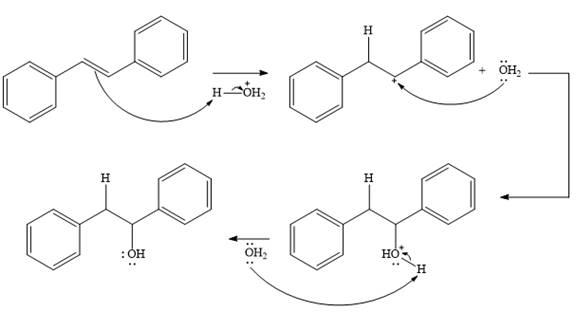
The product of the reaction is
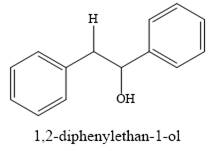
Explanation of Solution
The given addition reaction is
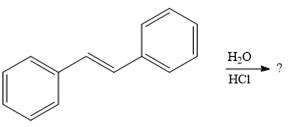
In the presence of HCl, the weak acid

In the next step, a molecule of water acts as a nucleophile and adds to the carbocation to form a protonated alcohol.

In the final step, another molecule of water deprotonates to give the final product,
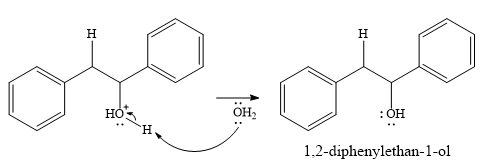
Thus, the complete mechanism for this addition reaction can be drawn as
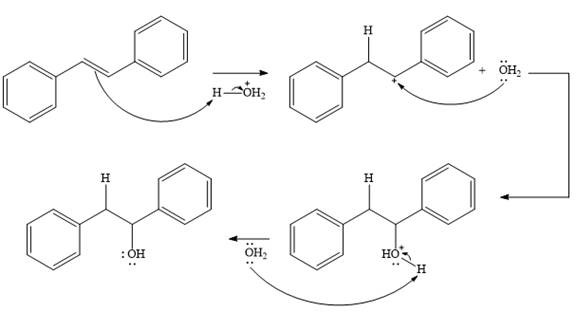
And the product of the reaction is

Weak Bronsted acids can add to an alkene in the presence of a strong acid.
(c)
Interpretation:
The complete, detailed mechanism for the given reaction is to be drawn and the product is to be predicted.
Concept introduction:
A weak acid can add to an alkene in the presence of a strong acid. Because of the leveling effect, the protonated form of a weak acid is the strongest acid that can exist, so the strong acid protonates the weak acid. This protonated form of the weak acid is a good electrophile because of the positive charge. The double bond in the alkene is an electron-rich region and behaves as a nucleophile. The
Answer to Problem 11.11P
The complete mechanism for the given addition reaction is

The product of the reaction is

Explanation of Solution
The given reaction is

In the presence of a strong acid

In the next step, a molecule of ethanol will act as a nucleophile and form a bond with the carbocation, using a lone pair on oxygen.
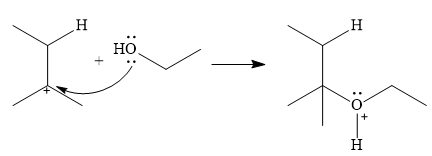
This results in the formation of protonated ether, which is deprotonated by another molecule of ethanol in the final step.

Thus, the complete mechanism for this addition reaction can be drawn as

And the product of the reaction is
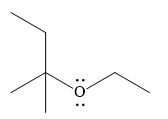
Weak Bronsted acids can add to an alkene in the presence of a strong acid.
(d)
Interpretation:
The complete, detailed mechanism for the given reaction is to be drawn and the product is to be predicted.
Concept introduction:
A weak acid can add to an alkene in the presence of a strong acid. Because of the leveling effect, the protonated form of a weak acid is the strongest acid that can exist, so the strong acid protonates the weak acid. This protonated form of the weak acid is a good electrophile because of the positive charge. The double bond in the alkene is an electron-rich region and behaves as a nucleophile. The
Answer to Problem 11.11P
The complete mechanism for the reaction is

The product of the reaction is
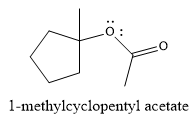
Explanation of Solution
The given reaction is

In the presence of

In the next step, a molecule of acetic acid will act as a nucleophile using a lone pair on OH oxygen to form a bond with the carbocation. The result is a protonated form of the ester product.

Final deprotonation by another molecule of acetic acid will give the product.

Thus, the complete mechanism for the reaction can be drawn as

The product of the reaction is

Weak Bronsted acids can add to an alkene in the presence of a strong acid.
Want to see more full solutions like this?
Chapter 11 Solutions
ORGANIC CHEMISTRY E-BOOK W/SMARTWORK5
- Predict the major products of the following reactions. Draw the complete, detailed mechanism that leads to the formation of each of those products.arrow_forwardPredict the major product of each of the reactions shown here and provide the complete, detailed mechanism.arrow_forwardDraw the complete mechanism and the major organic product for each of the following reactions.arrow_forward
- Please draw the complete, detailed mechanism for each of thesearrow_forwardDraw a complete, detailed mechanism for the following reaction. A key intermediate is provided.arrow_forward(SYN) Show how to synthesize the following molecule from any compounds containing two carbons. Draw the complete, detailed mechanism for the reaction.arrow_forward
- Draw the mechanism and the major organic product for each of the following reactions.arrow_forwardDraw the detailed mechanism, Need answer step by steparrow_forwardDetermine the major product of each reaction in Problem and draw the complete, detailed mechanism. Pay attention to stereochemistry where appropriate.arrow_forward
 ChemistryChemistryISBN:9781305957404Author:Steven S. Zumdahl, Susan A. Zumdahl, Donald J. DeCostePublisher:Cengage Learning
ChemistryChemistryISBN:9781305957404Author:Steven S. Zumdahl, Susan A. Zumdahl, Donald J. DeCostePublisher:Cengage Learning ChemistryChemistryISBN:9781259911156Author:Raymond Chang Dr., Jason Overby ProfessorPublisher:McGraw-Hill Education
ChemistryChemistryISBN:9781259911156Author:Raymond Chang Dr., Jason Overby ProfessorPublisher:McGraw-Hill Education Principles of Instrumental AnalysisChemistryISBN:9781305577213Author:Douglas A. Skoog, F. James Holler, Stanley R. CrouchPublisher:Cengage Learning
Principles of Instrumental AnalysisChemistryISBN:9781305577213Author:Douglas A. Skoog, F. James Holler, Stanley R. CrouchPublisher:Cengage Learning Organic ChemistryChemistryISBN:9780078021558Author:Janice Gorzynski Smith Dr.Publisher:McGraw-Hill Education
Organic ChemistryChemistryISBN:9780078021558Author:Janice Gorzynski Smith Dr.Publisher:McGraw-Hill Education Chemistry: Principles and ReactionsChemistryISBN:9781305079373Author:William L. Masterton, Cecile N. HurleyPublisher:Cengage Learning
Chemistry: Principles and ReactionsChemistryISBN:9781305079373Author:William L. Masterton, Cecile N. HurleyPublisher:Cengage Learning Elementary Principles of Chemical Processes, Bind...ChemistryISBN:9781118431221Author:Richard M. Felder, Ronald W. Rousseau, Lisa G. BullardPublisher:WILEY
Elementary Principles of Chemical Processes, Bind...ChemistryISBN:9781118431221Author:Richard M. Felder, Ronald W. Rousseau, Lisa G. BullardPublisher:WILEY





